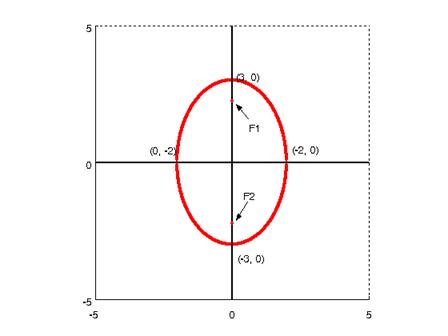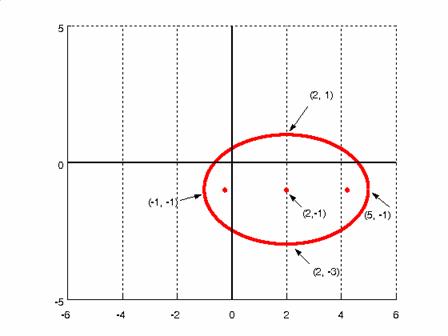Analytic Geometry: (lesson 2 of 3)
Ellipse
Definitions:
1. An ellipse is the figure
consisting of all those points for which the sum of their distances to two
fixed points (called the foci) is a constant.
2. An ellipse is the figure
consisting of all points in the plane whose Cartesian coordinates satisfy the
equation
( x − h ) 2 a 2 + ( y − k ) 2 b 2 = 1 \frac{(x - h)^2}{a^2} + \frac{(y - k)^2}{b^2} = 1 a 2 ( x − h ) 2 + b 2 ( y − k ) 2 = 1
Where h h h k k k a a a b b b a a a b b b
Formulas:
Equations
An ellipse centered at the point ( h , k ) (h, k) ( h , k )
( x − h ) 2 a 2 + ( y − k ) 2 b 2 = 1 \frac{(x - h)^2}{a^2} + \frac{(y - k)^2}{b^2} = 1 a 2 ( x − h ) 2 + b 2 ( y − k ) 2 = 1
Parametric equations of the ellipse:
x = h + a cos t y = k + b cos t − π ≤ t < π
\begin{aligned}
&x = h + a \cos t \\
&y = k + b \cos t \\
&-\pi \le t < \pi
\end{aligned}
x = h + a cos t y = k + b cos t − π ≤ t < π
Major axis = 2a
Minor axis = 2b
Eccentricity
Define a new constant 0 ≤ ε < 1 0 \le \varepsilon < 1 0 ≤ ε < 1 ε = 0 \varepsilon = 0 ε = 0
ε = 1 − b 2 a 2 \varepsilon = \sqrt{1 - \frac{b^2}{a^2}} ε = 1 − a 2 b 2
The greater the eccentricity is, the more elongated is the ellipse.
Foci:
If c c c
F 1 : ( h − a 2 − b 2 , k ) F 2 : ( h + a 2 − b 2 , k )
\begin{aligned}
&F1: \ \ \left( h - \sqrt{a^2 - b^2}, \ \ k \right) \\
&F2: \ \ \left( h + \sqrt{a^2 - b^2}, \ \ k \right)
\end{aligned}
F 1 : ( h − a 2 − b 2 , k ) F 2 : ( h + a 2 − b 2 , k )
The distance between the foci is
2 a ε 2 a \varepsilon 2 a ε
Area
The area enclosed by an ellipse is
π a b \pi a b πab a = b a = b a = b a 2 π a^2 \pi a 2 π
Tangent line
If
D ( x 0 , y 0 ) D(x_0, y_0) D ( x 0 , y 0 )
The equation of the tangent line in point
D ( x 0 , y 0 ) D(x_0, y_0) D ( x 0 , y 0 )
x 0 ( h − x ) a 2 + y 0 ( k − y ) b 2 = 1 \frac{x_0 (h - x)}{a^2} + \frac{y_0 (k - y)}{b^2} = 1 a 2 x 0 ( h − x ) + b 2 y 0 ( k − y ) = 1
Example 1:
Given the following equation
9 x 2 + 4 y 2 = 36 9x^2 + 4y^2 = 36 9 x 2 + 4 y 2 = 36
Find the length of the major and minor axes.
b) Find the coordinates of the foci.
c) Sketch the graph of the equation.
Solution:
a) First write the given equation in standard form:
9 x 2 + 4 y 2 = 36 / 36 9 x 2 36 + 4 y 2 36 = 1 x 2 4 + y 2 9 = 1 x 2 2 2 + y 2 3 2 = 1 → a = 2 ; b = 3
\begin{aligned}
9x^2 + 4y^2 &= 36 \ \ / \color{blue}{36} \\
\frac{9x^2}{36} + \frac{4y^2}{36} &= 1 \\
\frac{x^2}{4} + \frac{y^2}{9} &= 1 \\
\frac{x^2}{2^2} + \frac{y^2}{3^2} &= 1 \ \ \to \ \ \color{blue}{a = 2; \ b = 3}
\end{aligned}
9 x 2 + 4 y 2 36 9 x 2 + 36 4 y 2 4 x 2 + 9 y 2 2 2 x 2 + 3 2 y 2 = 36 / 36 = 1 = 1 = 1 → a = 2 ; b = 3
The major axis length is given by = 2 a = 4 = 2a = 4 = 2 a = 4
The minor axis length is given by = 2 b = 6 = 2b = 6 = 2 b = 6
b)
F 1 : ( h , k − b 2 − a 2 ) = ( 0 , 0 − 3 2 − 2 2 ) = ( 0 , − 5 ) F 2 : ( h , k + b 2 − a 2 ) = ( 0 , 0 + 3 2 − 2 2 ) = ( 0 , 5 )
\begin{aligned}
&F1: \ \ \left( h, k - \sqrt{b^2 - a^2} \right) = \left( 0,0 - \sqrt{3^2 - 2^2} \right) = \color{blue}{\left( 0, - \sqrt{5} \right)} \\
&F2: \ \ \left( h, k + \sqrt{b^2 - a^2} \right) = \left( 0,0 + \sqrt{3^2 - 2^2} \right) = \color{blue}{\left( 0, \sqrt{5} \right)}
\end{aligned}
F 1 : ( h , k − b 2 − a 2 ) = ( 0 , 0 − 3 2 − 2 2 ) = ( 0 , − 5 ) F 2 : ( h , k + b 2 − a 2 ) = ( 0 , 0 + 3 2 − 2 2 ) = ( 0 , 5 )
c)
Example 2:
Sketch the graph of the ellipse whose equation is
( x − 2 ) 2 9 + ( y + 1 ) 2 4 = 1 \frac{(x - 2)^2}{9} + \frac{(y + 1)^2}{4} = 1 9 ( x − 2 ) 2 + 4 ( y + 1 ) 2 = 1
Solution:
It can be seen that the center of the ellipse is ( h , k ) = ( 2 , − 1 ) (h, k) = (2, -1) ( h , k ) = ( 2 , − 1 ) a = 3 , b = 2 a = 3, b = 2 a = 3 , b = 2
It is known that the endpoints of the
major axis are exactly 3 units left and right from the center, which places them at
the points ( − 1 , − 1 ) (-1, -1) ( − 1 , − 1 ) ( 5 , − 1 ) (5, -1) ( 5 , − 1 )
It is, also, known that the endpoints of
the minor axis are exactly 2 units above and below the center, which places
them at the points ( 2 , 1 ) (2, 1) ( 2 , 1 ) ( 2 , − 3 ) (2, -3) ( 2 , − 3 )
Foci:
F 1 : ( h − a 2 − b 2 , k ) = ( 2 − 3 2 − 2 2 , − 1 ) = ( 2 − 5 , − 1 ) F 1 : ( h + a 2 − b 2 , k ) = ( 2 + 3 2 − 2 2 , − 1 ) = ( 2 + 5 , − 1 )
\begin{aligned}
&F1: \ \ \left( h - \sqrt{a^2 - b^2}, k \right) = \left( 2 - \sqrt{3^2 - 2^2}, -1 \right) = \left( 2 - \sqrt{5}, -1 \right) \\
&F1: \ \ \left( h + \sqrt{a^2 - b^2}, k \right) = \left( 2 + \sqrt{3^2 - 2^2}, -1 \right) = \left( 2 + \sqrt{5}, -1 \right)
\end{aligned}
F 1 : ( h − a 2 − b 2 , k ) = ( 2 − 3 2 − 2 2 , − 1 ) = ( 2 − 5 , − 1 ) F 1 : ( h + a 2 − b 2 , k ) = ( 2 + 3 2 − 2 2 , − 1 ) = ( 2 + 5 , − 1 )

